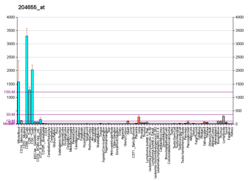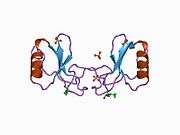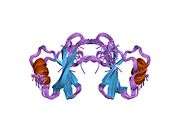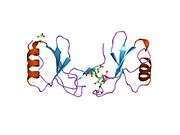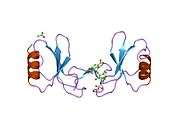CCL5
Chemokine (C-C motif) ligand 5 (also CCL5) is a protein which in humans is encoded by the CCL5 gene.[5] It is also known as RANTES (regulated on activation, normal T cell expressed and secreted).
Function
CCL5 is an 8kDa protein classified as a chemotactic cytokine or chemokine. CCL5 is chemotactic for T cells, eosinophils, and basophils, and plays an active role in recruiting leukocytes into inflammatory sites. With the help of particular cytokines (i.e., IL-2 and IFN-γ) that are released by T cells, CCL5 also induces the proliferation and activation of certain natural-killer (NK) cells to form CHAK (CC-Chemokine-activated killer) cells.[6] It is also an HIV-suppressive factor released from CD8+ T cells. This chemokine has been localized to chromosome 17 in humans.[5]
RANTES was first identified in a search for genes expressed "late" (3–5 days) after T cell activation. It was subsequently determined to be a CC chemokine and expressed in more than 100 human diseases. RANTES expression is regulated in T lymphocytes by Kruppel like factor 13 (KLF13).[7][8][9][10] RANTES, along with the related chemokines MIP-1alpha and MIP-1beta, has been identified as a natural HIV-suppressive factor secreted by activated CD8+ T cells and other immune cells.[11] Recently, the RANTES protein has been engineered for in vivo production by Lactobacillus bacteria, and this solution is being developed into a possible HIV entry-inhibiting topical microbicide.[12]
Interactions
CCL5 has been shown to interact with CCR3, [13] [14] CCR5[14][15][16] and CCR1.[14][16]
CCL5 also activates the G-protein coupled receptor GPR75. [17]
See also
References
- 1 2 3 ENSG00000274233 GRCh38: Ensembl release 89: ENSG00000271503, ENSG00000274233 - Ensembl, May 2017
- 1 2 3 GRCm38: Ensembl release 89: ENSMUSG00000035042 - Ensembl, May 2017
- ↑ "Human PubMed Reference:".
- ↑ "Mouse PubMed Reference:".
- 1 2 Donlon TA, Krensky AM, Wallace MR, Collins FS, Lovett M, Clayberger C (March 1990). "Localization of a human T-cell-specific gene, RANTES (D17S136E), to chromosome 17q11.2-q12". Genomics. 6 (3): 548–53. doi:10.1016/0888-7543(90)90485-D. PMID 1691736.
- ↑ Maghazachi AA, Al-Aoukaty A, Schall TJ (February 1996). "CC chemokines induce the generation of killer cells from CD56+ cells". Eur. J. Immunol. 26 (2): 315–9. doi:10.1002/eji.1830260207. PMID 8617297.
- ↑ Schall TJ, Jongstra J, Dyer BJ, Jorgensen J, Clayberger C, Davis MM, Krensky AM (August 1988). "A human T cell-specific molecule is a member of a new gene family". J. Immunol. 141 (3): 1018–25. PMID 2456327.
- ↑ Alan M. Krensky (1995). Biology of the Chemokine in Rantes (Molecular Biology Intelligence Unit). R G Landes Co. ISBN 1-57059-253-5.
- ↑ Song A, Chen YF, Thamatrakoln K, Storm TA, Krensky AM (January 1999). "RFLAT-1: a new zinc finger transcription factor that activates RANTES gene expression in T lymphocytes". Immunity. 10 (1): 93–103. doi:10.1016/S1074-7613(00)80010-2. PMID 10023774.
- ↑ Song A, Nikolcheva T, Krensky AM (October 2000). "Transcriptional regulation of RANTES expression in T lymphocytes". Immunol. Rev. 177: 236–45. doi:10.1034/j.1600-065X.2000.17610.x. PMID 11138780.
- ↑ Cocchi F, DeVico AL, Garzino-Demo A, Arya SK, Gallo RC, Lusso P (December 1995). "Identification of RANTES, MIP-1 alpha, and MIP-1 beta as the major HIV-suppressive factors produced by CD8+ T cells". Science. 270 (5243): 1811–5. doi:10.1126/science.270.5243.1811. PMID 8525373.
- ↑ Vangelista L, Secchi M, Liu X, Bachi A, Jia L, Xu Q, Lusso P (July 2010). "Engineering of Lactobacillus jensenii to secrete RANTES and a CCR5 antagonist analogue as live HIV-1 blockers". Antimicrob. Agents Chemother. 54 (7): 2994–3001. doi:10.1128/AAC.01492-09. PMC 2897324. PMID 20479208. Lay summary – Science Daily.
- ↑ Daugherty BL, Siciliano SJ, DeMartino JA, Malkowitz L, Sirotina A, Springer MS (May 1996). "Cloning, expression, and characterization of the human eosinophil eotaxin receptor". J. Exp. Med. 183 (5): 2349–54. doi:10.1084/jem.183.5.2349. PMC 2192548. PMID 8642344.
- 1 2 3 Struyf S, Menten P, Lenaerts JP, Put W, D'Haese A, De Clercq E, Schols D, Proost P, Van Damme J (July 2001). "Diverging binding capacities of natural LD78beta isoforms of macrophage inflammatory protein-1alpha to the CC chemokine receptors 1, 3 and 5 affect their anti-HIV-1 activity and chemotactic potencies for neutrophils and eosinophils". Eur. J. Immunol. 31 (7): 2170–8. doi:10.1002/1521-4141(200107)31:7<2170::AID-IMMU2170>3.0.CO;2-D. PMID 11449371.
- ↑ Slimani H, Charnaux N, Mbemba E, Saffar L, Vassy R, Vita C, Gattegno L (October 2003). "Interaction of RANTES with syndecan-1 and syndecan-4 expressed by human primary macrophages". Biochim. Biophys. Acta. 1617 (1–2): 80–8. doi:10.1016/j.bbamem.2003.09.006. PMID 14637022.
- 1 2 Proudfoot AE, Fritchley S, Borlat F, Shaw JP, Vilbois F, Zwahlen C, Trkola A, Marchant D, Clapham PR, Wells TN (April 2001). "The BBXB motif of RANTES is the principal site for heparin binding and controls receptor selectivity". J. Biol. Chem. 276 (14): 10620–6. doi:10.1074/jbc.M010867200. PMID 11116158.
- ↑ Ignatov A, Robert J, Gregory-Evans C, Schaller HC (November 2006). "RANTES stimulates Ca2+ mobilization and inositol trisphosphate (IP3) formation in cells transfected with G protein-coupled receptor 75". Br. J. Pharmacol. 149 (5): 490–7. doi:10.1038/sj.bjp.0706909. PMC 2014681. PMID 17001303.
External links
- Human CCL5 genome location and CCL5 gene details page in the UCSC Genome Browser.
Further reading
- Muthumani K, Desai BM, Hwang DS, Choo AY, Laddy DJ, Thieu KP, Rao RG, Weiner DB (2004). "HIV-1 Vpr and anti-inflammatory activity". DNA Cell Biol. 23 (4): 239–47. doi:10.1089/104454904773819824. PMID 15142381.
- Zhao RY, Elder RT (2005). "Viral infections and cell cycle G2/M regulation". Cell Res. 15 (3): 143–9. doi:10.1038/sj.cr.7290279. PMID 15780175.
- Zhao RY, Bukrinsky M, Elder RT (2005). "HIV-1 viral protein R (Vpr) & host cellular responses". Indian J. Med. Res. 121 (4): 270–86. PMID 15817944.
- Li L, Li HS, Pauza CD, Bukrinsky M, Zhao RY (2006). "Roles of HIV-1 auxiliary proteins in viral pathogenesis and host-pathogen interactions". Cell Res. 15 (11–12): 923–34. doi:10.1038/sj.cr.7290370. PMID 16354571.
- Ignatov A, Robert J, Gregory-Evans C, Schaller HC (Nov 2006). "RANTES stimulates Ca2+ mobilization and inositol trisphosphate (IP3) formation in cells transfected with G protein-coupled receptor 75". Br J Pharmacol. 149 (5): 490–7. doi:10.1038/sj.bjp.0706909. PMC 2014681. PMID 17001303.






